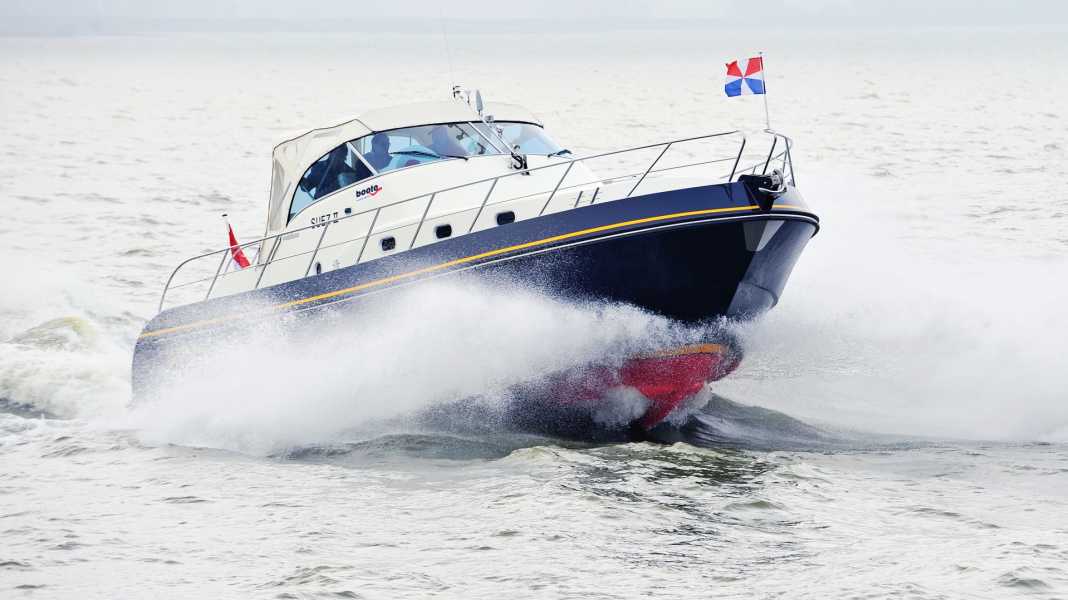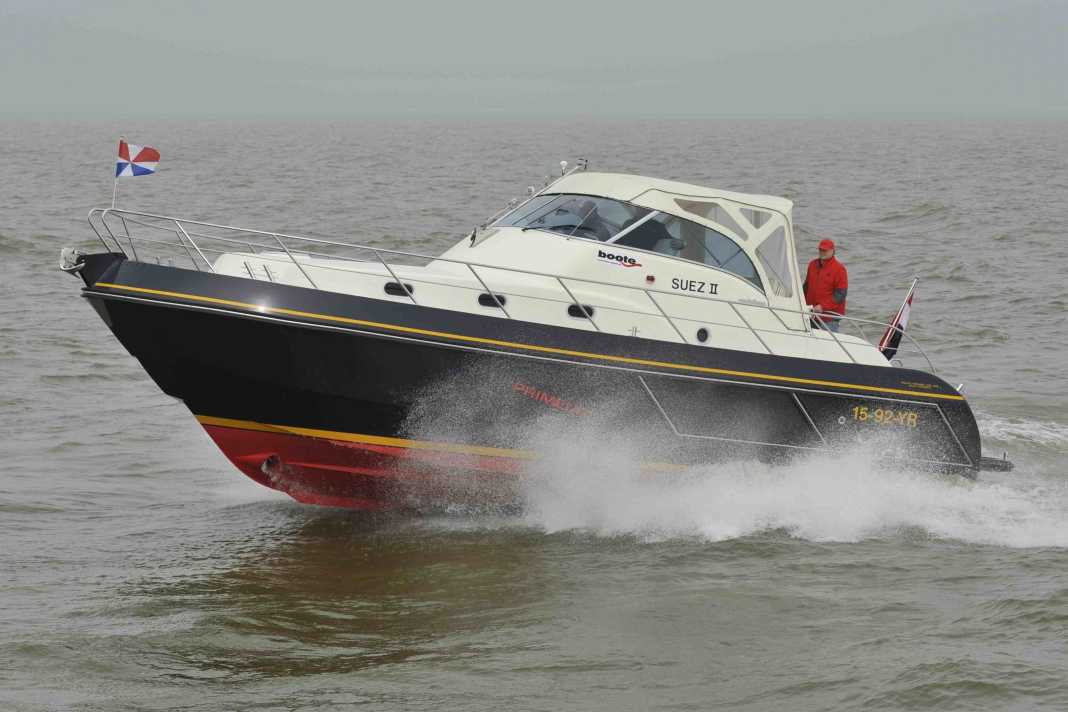
The majority of Dutch boats are built from steel. A tradition that has become more and more established over the last few decades and is also recognised by P.Valk Yachts is operated successfully. However, the shipyard has been focusing on another mainstay since 1966: the construction of aluminium boats.






Our test boat, the Nemo 35-38 Sport, is one of these types. The two numbers at the end give you an idea that this is no ordinary boat, but a "changeable" one. The bathing platform can be folded up hydraulically, leaving 35 feet of the original 38 feet. The advantage is cheaper mooring fees and winter storage. With about 1 metre less boat, it is easier to wriggle into the lock. At the anchorage, the large bathing platform can be lowered at the touch of a button and used as normal.
Shipyard boss P. Valk advertises his Nemo as an inland displacement boat, but it is just as good as a glider at sea (CE category B). We sailed the boat on the Ijsselmeer in a wind of around 5 Beaufort. The Nemo was very comfortable in the short choppy waves. With only a little splash water, it starts up audibly, but "back-friendly". At high speed, the hull remains stable in all directions.
With displacement speed and aft waves, you have to compensate for the course to some extent, but this is in the nature of things when you are overtaken by waves. We measured a top speed of 29 knots on the test day; the two diesels (Yanmar 220 hp) turn at exactly the 4000 rpm permitted by the manufacturer.
In this situation, they consume 88 l/h according to Yanmar's own digital display. This results in 3.08 l/sm, and one tank of fuel (1100 l) minus 15 % is enough for a suitable 308 nm. The journey goes a little further if the engines are throttled back to 3750 rpm (25 knots). The skipper can travel almost twice as far at 7 kn (approx. hull speed).
In fast turns, the hull pulls its laps safely without rocking or hooking, even in rough water. At the tightest point of the circle, the propellers grab air and you have to take the throttle off briefly to restart. Due to the long ratio of the hydraulic steering, slalom manoeuvres and steering lock are sluggish and smooth.
In a calm harbour, our test boat shows that it is stable on course even at slow displacement speeds. Harbour manoeuvres are easy and precise thanks to the twin engines (gearboxes engaged in opposite directions) and the bow thruster.
The driver operates this using a well-positioned dual switch (electric) and push-button panel (thruster). Switches for the trim tabs and the power trim (Z-drives) are also within easy reach. However, the latter are not required for normal sailing. The boat is only brought into the optimum position with the flaps, which show their advantages particularly in the transition range (approx. 2500/min-3500/min).
You don't necessarily need the hatches at full throttle; even without them, visibility remains good when standing and sitting. The skipper is seated on a fold-down (starboard berth extension), but somewhat too softly padded seat. The distance to the steering wheel is user-friendly and there is plenty of legroom. Co-pilots have a safe place on a double bench to port.
The car pool is protected by a convertible top with plenty of foil windows and a slightly tinted safety glass pane. Praise: no windscreen frame in the field of vision, two large wipers and only moderate reflections. The latter also applies to the good instrument visibility. Drawback: navigation instruments are on the surcharge list.
The engines are located under a double floor in the rear cockpit area. The advantage of this encapsulation is that the maximum noise level is 83 dB/A. The entire engine compartment is easily accessible via removable panels, and the technicians installed the technical equipment professionally. Apart from a few unbroken edges on the fixtures and dust inclusions in the cockpit table paintwork, this also applies to the fixtures, paintwork and metalwork.
Life in the open air takes place mainly in the cockpit, which is divided by a step. There is an open area aft and a table and two combination seating areas (sunbed/seat) on each side forward. One level down, our two-cabin version has a spacious saloon with a huge, semi-circular seating area and well-equipped galley.
Sleeping is in two centre cabins, with the cabin to starboard being well suited for children or guests due to its smaller size and the larger one to port as the "owner's suite". The upholstery is soft and, according to the shipyard, has an integrated mesh insert for ventilation. Practically designed: the separate WC and shower rooms, both of which offer a suitable amount of space. There are plenty of options for stowing clothing and equipment on and below deck.
The safety equipment includes an exemplary fire extinguishing system in the engine compartment and a 2-kg extinguisher. Four electric bilge pumps are a lot, but we still miss the powerful hand bilge pump, which also works without electricity. A large number of handrails, the railing and the non-slip floor structures ensure safe movement.
Conclusion: The Nemo 35-38 is a rock-solid boat with good driving and manoeuvring characteristics that is suitable for both inland waterways and at sea.
Data sheet: Valk Nemo 35-38 Sport
Shipyard: P. Valk Yachts
Type designation: Valk Nemo 35-38 Sport
CE category: B - Outside coastal waters
Material of hull and deck: Aluminium
Length: 11,80 m
Width: 4,10 m
Displacement: 9,50 t
Price: 449.000,00 €

